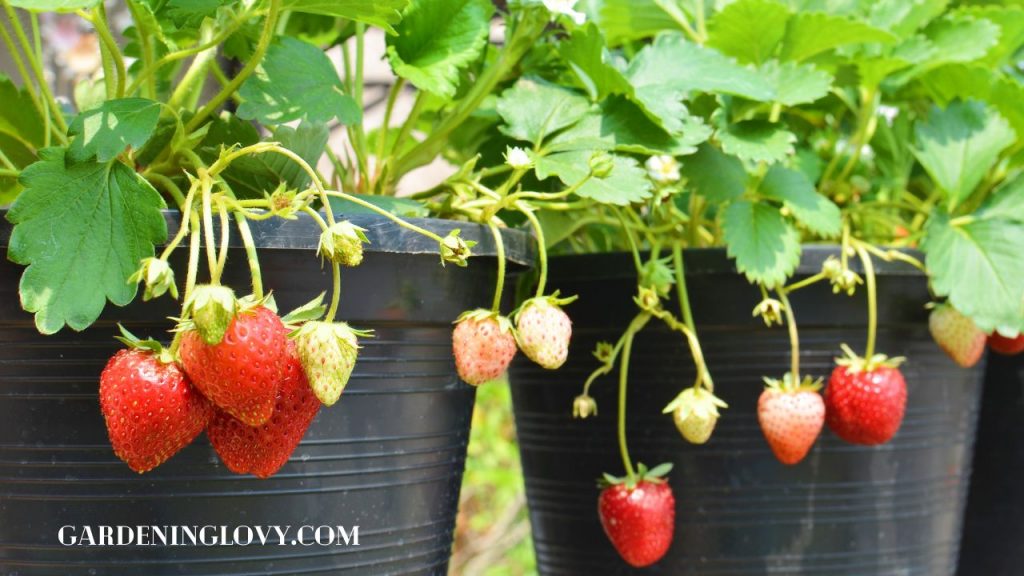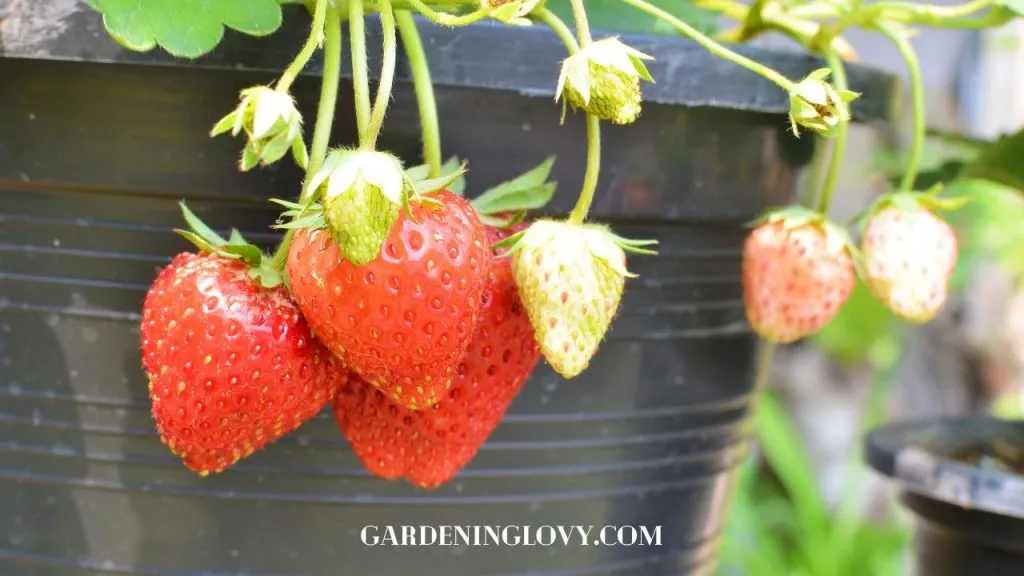There are multiple uses for strawberries so it’s important to grow them carefully. In this blog, learn how to care for strawberry plants and when to plant strawberries.
Strawberries are prized for their luscious red color and sweet, rich flavor. In practically every cuisine and culture, they are a favorite berry.
Few people have considered planting them, despite many routinely utilizing them in their cuisine (or snacking).
Strawberry plants can be grown inexpensively and easily from seed. If given the minimal necessities, native plants of North America don’t much care where they spread.

It’s vital to keep in mind that growing strawberries from seed takes time, and depending on the region and the length of the growth cycle, it’s conceivable that the plant will begin producing berries in the following year.
However, if you pay close attention and persist, you will eventually get to appreciate the fruit. Here learn how to care for strawberry plants: learn the correct growing conditions and tactics to avoid common plant decaying problems.
How To Care For Strawberry Plants?
There are several ways you can grow your strawberry like aeroponics, hydroponics.
The following advice can help the plant recover, encourage healthy crown development, and produce more flowers and strawberries. So that you can harvest and store strawberries longer.
1. Place Fresh Potting Soil In The Pots Of Indoor Plants.
Brown patches can easily appear on strawberry shrubs, but they can be stopped by transplanting plants into a larger pot with new potting soil.
2. Use Clean, Immaculate Pruning Shears To Remove Any Old Leaves.
Typically, they would begin near the base of the plant, with fresh leaflets emerging from the center. Since more light can reach the fronds, removing old leaves may speed up the plant’s healing.
After purchasing some premium all-purpose soil, gently remove the old gravel. Give the shrub lots of water during the first week after replanting to keep it moist.
3. Keep The Plant Well-Hydrated.
Strawberries should always be regularly watered, especially in the summer.
In arid regions, strawberry plants require hydration every two to three days during the summer to sustain healthy growth and reduce the probability of brown leaves.
4. Utilize A Mild Organic Fertilizer.
Feed strawberry plants pelleted chicken manure in the spring and again in the fall to give them the nitrogen they require to grow new leaves.
For indoor plants, an unscented, slow-release meal is ideal.
5. Completely Enclose The Plants.
Hay, straw, and bark can be used as mulch around plants to keep the soil moist longer. It will eventually help to improve the topsoil and inhibit weed development.
Click below to buy strawberry plant runners.
Keep a distance from the top of the strawberry plant and add a layer of 2-3 inches all around the root system to prevent rot.
6. Put The Strawberry Plants In A Room With More Light.
Put the indoor strawberry plants in a location that receives more direct sunshine.
A sunny window or even an ultraviolet grow lamp will improve your plants’ capacity to photosynthesize and keep fronds efficiently.
Types Of Strawberries
June-bearing, spring-bearing (which produces strawberries early in the growing season), and everbearing are the three primary varieties of strawberry plants, with the last category producing fruit all the summertime.
Here are a few types Honeoye, Earliglow, Allstar, Ozark Beauty, Chandler and Jewel.
There are numerous variations within these groups; therefore, for the species that thrive in your region, speak with the local gardening nursery or agricultural office.
When To Plant Strawberry Plant?

Make plans to plant as quickly as the soil can be plowed in the springtime. See the frost predictions in your area.
To maintain excellent strawberry yield every season, grow fresh plants annually.
The runners (baby plants) that strawberry plants generate will gain a foothold and grow into fresh strawberry plants.
Purchase Strawberry plants resistant to any disease from a reliable florist and of a type popular in the region.
For information on regionally suggested kinds, speak with the grower where you purchased plants.
Selecting and Getting Ready for a Planting Spot
Pick the planting location wisely because strawberry plants need approximately 10 hours in the bright sun each day.
- While strawberries may grow in various soil types, they favor loamy, well-draining soil. Put in seasoned compost or manure, preferably a few months after planting.
- To increase permeability further, scrape clay content into elevated mounds or often blend in three inches more than compost.
- Very softly cultivate fine sand to get rid of plants before adding a 1-inch coating of rich fertilizer or rotting manure.
- The ideal pH range for soil is 5.5 to 7. Before planting, adjust the soil if required.
- It is recommended to grow berries inside half-barrels and other big planters loaded with nutrient soil mix if the soil in the region is already alkaline.
The planting area has to have good drainage. Strawberry plants thrive exceptionally well on garden beds.
Strawberry Plant Care During Winter
Strawberry plants grow year after year. They can withstand somewhat frigid weather since they are inherently cold-hardy.
- Only a little attention is required if the winter in the region is moderate.
- Strawberries would be inactive in areas where the weather consistently falls into the range of the twenties (°F). Giving little winter insulation is better.
- Mow or trim plants with one inch whenever the growth cycle is ended. After the initial cold spells or once the temperature reaches 20 Fahrenheit (-6 Celsius).
- Mulch bushes using straw, pine cones, or even other plant matter to a depth of around 4 inches. Additional insulating mulch needs to be applied in considerably colder places.
The soil’s proper moisture must be maintained by periodic precipitation. When the threat of frost has subsided in the springtime, take out the mulch.
What Are The Adverse Effects If Proper Care Is Not Provided While Growing Strawberry Plants?
Every gardener desires healthy, regular growth and development for their plants. The hue of the plant’s leaves indicates how well the crop is producing.
- Green fronds are an indication that the plant is thriving and will produce nutrient-rich fruit.
- The foliage of strawberries is among the first plant parts to display symptoms of a disease, along with their fruits.
- Red strawberries and green foliage are signs that a plant is doing well and that the berries are thriving for the grower.
Unfortunately, many growers have to deal with the plants’ leaves turning brown, which can happen for several reasons and acts as a warning that something might be wrong.
Now, what are you doing wrong? Well, many mistakes can push the strawberry plants off the cliff; some are mentioned below.
1. Waterlogging
Waterlogging or overwatering may cause the browning of the strawberry plant’s leaves since strawberries dislike having their roots placed in soil that is too wet.
The plant might suffer if you were overwatering it.
When it comes to hydration, strawberries only require balance; if you water them at the right time and in the right amount, the plant should flourish.
2. Underwatering
Another cause of discoloration is underwatering, which does not give the plant enough fresh water.
In the summertime, berries are more prone to dehydration, and insufficient hydration can cause discoloration.
- Read- Waterlogging vs Underwatering, to understand better.
3. Adding No Fertilizer
Overplanting or a lack of fertilizer in the soil are common causes. By lowering the chlorophyll produced, browning is brought on by the absence of chloroplasts.
The best action in this situation would be to purchase fertilizer, whether NPK or organic fertilizer.
3. Proper Sunlight
Strawberries thrive when grown in warm climates, where they receive eight to ten hours of daily sunshine, which is a vital requirement for their successful survival.
The more exposure strawberry plants receive, the more nutrient-rich red berries they produce.
Many strawberry plants require at least 6 to 8 hours of daylight daily. However, if the sun gets too hot, it could burn the fruit.
4. Pest Infestation
The leading causes of discoloration on the strawberry leaf are bacteria and insects.
At some point in their life, crops may combat diseases and bugs, which are growing increasingly common.
Pest infestations may result in problems including leaf spots, Verticillium wilt, leaf blight, and many others.
what to do with strawberry plants at end of season
how to make strawberry plants produce more fruit
caring Strawberry Plants FAQs
Q: How To Harvest My Strawberries?
You are prepared to pick strawberries after growing and tending to them for a few years.
Prior to harvesting, strawberries must fully mature on the plant.
Only after berries have reached their peak of hue most kinds must be kept upon that plant for about one to two nights.
However, the only way to tell if one is prepared is to taste it!
Q: Why Are There White Patches On My Strawberry Plant?
Podosphaera aphanisi, a fungus that may infect all parts of the strawberry plant, including the blossoms and fruit, is believed to be the main culprit behind the infection.
Fuzzy white spots that later turn red, then purple, and ultimately brown are the earliest symptoms that can be seen on the foliage.
Purchase antifungals and follow the package’s directions to solve powdery mildew problems. If at all feasible, pick an organic pesticide.
Wrapping It Up: How To Care For Strawberry Plants
Planting different types of strawberries throughout the year may be easy if proper care is given.
Gardeners who always ask when to plant strawberry plants or how to care for strawberry plants can use the information above to assist them in growing strawberry plants.
Furthermore, they can also create the proper harvesting routine.

My name is Olivia, and I live in the United States and love having plants in my garden. Lots of plants are there on my balcony, indoor and outdoor garden also. Here I am trying to share useful gardening tips, how to grow and care for various plants, etc.

